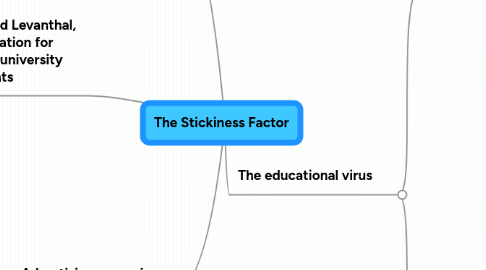
1. The message needs to be sticky
1.1. Advertisments
1.1.1. For example, Coca-cola or Nike. They have plenty of money to spend on fancy advertisments
2. Howard Levanthal, vaccination for senior university students
2.1. Different versions of booklet giving info
2.1.1. 'High fear'
2.1.1.1. Understood the importance and convinced of the dangers
2.1.1.2. Were more likely to get inoculated
2.1.1.2.1. Social stigma, intimidated by the medical care itself?
2.1.2. Maybe it wasn't the conception of the message at all...
2.1.2.1. Added map to booklet and gave times when shots available then an equal amount of students from the 'high fear' as the 'low fear' group got inoculated! Why?
2.1.2.1.1. Gave them a map they did not need, more than likely have visited the building before..Didn't need an 'avalanche of new or additional information'. Just a subtle but significant change in presentation of the booklet.
2.1.3. 'Low fear'
2.1.3.1. Only 3% actually got inoculated
3. Advertising campaign
3.1. Lester Wunderman
3.1.1. "Tresaure hunt" - Secret of the golden box
3.1.1.1. Succeeded because they interacted with the audience
3.1.2. Stayed away from prime time slots, went against principles of advertising
3.2. Columbia Record Club
3.2.1. Creativity and sophistication. Did all the big things right but didn't have that little final touch
4. The educational virus
4.1. Sesame Street
4.1.1. "You try to find the kids strengths so you can play on them. You try to understand the kids weaknesses so you can avoid them" - Gerald Lesser
4.1.1.1. If kids couldn't make sense of what they weren't going to look at it
4.1.2. Made small but critial adjustments in how they presented ideas to the preschoolers
4.1.2.1. succeeded because they learned how to make television sticky, after years of experiments, test and observation
4.1.3. Never had much money to spend on making the program sticky. The subtle changes made the difference
4.1.4. Built about a single, breakthrough insight that if you can hold the attention of children you can educate them
4.1.5. Had a small number of insignificant limitations, including not enough interaction with the audience and that the puns are directed to adults mainly
4.1.6. Intended to appeal to both adults and kids (kids didn't understand the puns)
4.1.6.1. Can understand how childrens programs could be improved
4.1.6.1.1. Managed to overcome what may have been overwhelming obsticles
4.1.7. 'HUG' - success
4.1.7.1. Focused on the word/letters
4.1.7.2. Stayed away from prime slots, went against principles of advertising
4.1.8. 'Osacars Blending' - failure
4.1.8.1. Word at the bottom of screen, kids focued on Oscar instead of the word. 'Oscar was sticky. The lesson wasn't'
4.2. Blue's Clues
4.2.1. Not as long as Sesame Street and video version of a story book helped to make it more successful
4.2.2. Took sticky elements from Sesame Street and made them stickier
4.2.2.1. Kids like being intelectually active and behaviourally active
4.2.2.1.1. Participate and being involved
4.2.3. Kids can't understand theories of how and why things happen so they use stories in a narrative manner, otherwise they wouldn't remember things
4.2.3.1. Study (on a two year old girl) Narratives from the Crib
4.2.3.1.1. Talked to herself before she went to sleep at night (which was recorded and analyzed) more advanced than conversations with her parents
4.2.4. Repetition - The James Earl Jones Effect
4.2.4.1. Kids liked this. They were sequencing themselves through the piece
4.2.4.2. Ran the same show five days straight
4.2.4.2.1. Attention and comprehension increased over the week. They understand it better, giving them a sense of affirmation and selfworth
4.2.4.2.2. Andersons daughter watched it fourteen times without lagging in enthusiasm
4.2.5. Succeeds as a story of discovery, only if the clues are in the proper order. easy to start with giving the viewer confidence then gets progressively harder challenging them
